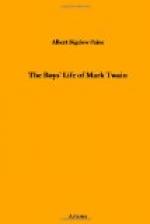The brothers went at once to St. Louis for final leave-taking, and there took boat for “St. Jo,” Missouri, terminus of the great Overland Stage Route. They paid one hundred and fifty dollars each for their passage, and about the end of July, 1861, set out on that long, delightful trip, behind sixteen galloping horses, never stopping except for meals or to change teams, heading steadily into the sunset over the billowy plains and snow-clad Rockies, covering the seventeen hundred miles between St. Jo and Carson City in nineteen glorious days.
But one must read Mark Twain’s “Roughing It” for the story of that long-ago trip—the joy and wonder of it, and the inspiration. “Even at this day,” he writes, “it thrills me through and through to think of the life, the gladness, and the wild sense of freedom that used to make the blood dance in my face on those fine overland mornings.”
It was a hot dusty, August day when they arrived, dusty, unshaven, and weather-beaten, and Samuel Clemens’s life as a frontiersman began. Carson City, the capital of Nevada, was a wooden town with an assorted population of two thousand souls. The mining excitement was at its height and had brought together the drift of every race.
The Clemens brothers took up lodgings with a genial Irishwoman, the Mrs. O’Flannigan of “Roughing It,” and Orion established himself in a modest office, for there was no capitol building as yet, no government headquarters. Orion could do all the work, and Samuel Clemens, finding neither duties nor salary attached to his position, gave himself up to the study of the life about him, and to the enjoyment of the freedom of the frontier. Presently he had a following of friends who loved his quaint manner of speech and his yarns. On cool nights they would collect about Orion’s office-stove, and he would tell stories in the wonderful way that one day would delight the world. Within a brief time Sam Clemens (he was always “Sam” to the pioneers) was the most notable figure on the Carson streets. His great, bushy head of auburn hair, has piercing, twinkling eyes, his loose, lounging walk, his careless disorder of dress invited a second look, even from strangers. From a river dandy he had become the roughest-clad of pioneers—rusty slouch hat, flannel shirt, coarse trousers slopping half in and half out of heavy cowhide boots, this was his make-up. Energetic citizens did not prophesy success for him. Often they saw him leaning against an awning support, staring drowsily at the motley human procession, for as much as an hour at a time. Certainly that could not be profitable.
But they did like to hear him talk.
He did not catch the mining fever at once. He was interested first in the riches that he could see. Among these was the timber-land around Lake Bigler (now Tahoe)—splendid acres, to be had for the asking. The lake itself was beautifully situated.
With an Ohio boy, John Kinney, he made an excursion afoot to Tahoe, a trip described in one of the best chapters of “Roughing It.” They staked out a timber claim and pretended to fence it and to build a house, but their chief employment was loafing in the quiet luxury of the great woods or drifting in a boat on the transparent water. They did not sleep in the house. In “Roughing It” he says:




